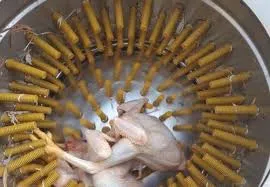Poultry Processing Techniques Utilizing Scalding Tanks for Effective Feather Removal
Nov . 26, 2024 17:32 Back to list
Poultry Processing Techniques Utilizing Scalding Tanks for Effective Feather Removal
The Importance of Scalding Tanks in Poultry Processing
In the poultry processing industry, maintaining high standards of hygiene and quality is crucial. One of the critical stages in this process is scalding, which is facilitated by scalding tanks. These tanks play a pivotal role in ensuring that poultry is prepared for further processing, ultimately influencing both safety and product quality.
What is Scalding?
Scalding refers to the process of immersing freshly slaughtered birds in hot water, typically between 140°F to 160°F (60°C to 71°C), for a brief period. The primary purpose of scalding is to loosen the feathers from the skin of the birds, making the plucking process more efficient. This step is essential not only for the removal of feathers but also for the maintenance of meat quality and safety.
The Role of Scalding Tanks
Scalding tanks are large vessels designed to hold hot water and are specifically engineered for poultry processing. These tanks ensure even distribution of heat and maintain consistent water temperatures throughout the scalding process. They are usually equipped with mechanisms to facilitate water circulation, preventing hot and cold spots which could lead to uneven scalding results.
There are two primary types of scalding tanks used in poultry processing
1. Static Scalding Tanks These are traditional tanks where birds are immersed in heated water for a specified time. While effective, they can be less efficient in terms of water usage and heating.
2. Continuous Scalding Tanks This modern approach allows the birds to pass through a flow of hot water, providing a more efficient and uniform scalding process. Continuous scalding systems also help conserve water and energy, making them more sustainable options for poultry processors.
Key Advantages of Using Scalding Tanks
1. Enhanced Feather Removal One of the primary advantages of using scalding tanks is the improvement in feather removal. Proper scalding ensures that feathers are removed cleanly and efficiently without damaging the skin of the poultry, which is vital for product presentation and consumer appeal.
scalding tank poultry

2. Improved Meat Quality Scalding helps to relax the muscles of the birds, reducing stress and improving the overall quality of the meat. When poultry is handled gently and properly scalded, it is less likely to experience bruising, leading to a better end product for consumers.
3. Pathogen Reduction The hot water used in scalding can help to eliminate surface bacteria and pathogens that may be present on the poultry. By reducing microbial loads, scalding contributes to food safety, ensuring that the poultry products meet health regulations and are safe for consumer consumption.
4. Increased Efficiency Modern scalding tanks are designed to maximize efficiency. They integrate advanced technology to monitor water temperature and flow, allowing processors to maintain optimal conditions throughout the scalding process. This automation can increase throughput and reduce labor costs.
Best Practices for Scalding Tanks
To ensure that scalding tanks operate effectively, several best practices should be followed
- Regular Maintenance Routine checks and maintenance of scalding tanks are essential to ensure they operate efficiently. Cleaning and inspecting the tanks regularly can prevent contamination.
- Temperature Monitoring Maintaining the correct temperature is crucial for effective scalding. Implementing automated monitoring systems can help processors keep the water temperature within the desired range.
- Water Quality Management The quality of water used in scalding is important. Regular testing and treatment of water ensure that it remains free from contaminants that could affect the final product.
Conclusion
Scalding tanks are a fundamental component of poultry processing, significantly impacting the efficiency, hygiene, and quality of poultry products. By investing in modern scalding technology and adhering to best practices, poultry processors can enhance their operations and deliver safe, high-quality products to consumers. As the poultry industry continues to evolve, the role of scalding tanks will undoubtedly remain crucial in ensuring that poultry products meet the highest standards of quality and safety.
-
Hot Sale 24 & 18 Door Rabbit Cages - Premium Breeding Solutions
NewsJul.25,2025
-
Automatic Feeding Line System Pan Feeder Nipple Drinker - Anping County Yize Metal Products Co., Ltd.
NewsJul.21,2025
-
Automatic Feeding Line System Pan Feeder Nipple Drinker - Anping County Yize Metal Products Co., Ltd.
NewsJul.21,2025
-
Automatic Feeding Line System - Anping Yize | Precision & Nipple
NewsJul.21,2025
-
Automatic Feeding Line System - Anping Yize | Precision & Nipple
NewsJul.21,2025
-
Automatic Feeding Line System-Anping County Yize Metal Products Co., Ltd.|Efficient Feed Distribution&Customized Animal Farming Solutions
NewsJul.21,2025






